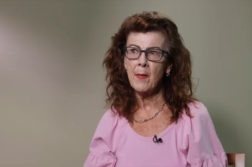SAN ANTONIO, Texas (Ivanhoe Newswire) – Brain lesions occur in 90 percent of patients over 65, and they are often among the first signs of dementia. The key is knowing how many lesions are lodged in the brain, and where they are. Counting them is nearly impossible, so, researchers are turning to artificial intelligence to do that in mere seconds.
Director of neuroimaging at UT Health in San Antonio, Mohamad Habes, studies MRI scans to find lesions in the brain deeply lodged in perivascular folds.
“They are tiny and because of their small size, it could be difficult for a clinician to really count all of them,” Habes says.
And because people over 70 could have hundreds of lesions in the perivascular space, counting them becomes next to impossible.
Habes explains, “We have developed a sophisticated system that is able to detect and quantify those lesions one by one throughout the whole brain.”
Small vessel disease lesions are formed from damaged brain tissue, triggered by vascular disease or injury.
“We see them a lot in people who have traumatic brain injuries. A hit on the brain, on the frontal lobe, for example, could cause a lesion,” Habes mentions.
And that affects how a person walks or talks. Doctors know that when an older person changes their gait, or way of walking, it can be an early indicator of dementia.
“It doesn’t mean that the moment you develop these lesions, you will develop dementia, but it means your risk of developing dementia would be greater,” Habes further explains.
Habes says this groundbreaking AI algorithm offers people a chance to improve lifestyle choices and stave off dementia. He also says this breakthrough study should lead to clinical application within a year, so doctors can easily uncover cerebral small-vessel disease in the blink of an eye by using AI.
Contributors to this news report include: Donna Parker, Producer; Bruce Maniscalco, Videographer; Roque Correa, Editor.
To receive a free weekly e-mail on medical breakthroughs from Ivanhoe, sign up at: http://www.ivanhoe.com/ftk
Source:
MEDICAL BREAKTHROUGHS
RESEARCH SUMMARY
TOPIC: AI LOCATES BRAIN LESIONS IN SECONDS!
REPORT: MB #5294
BACKGROUND: A brain lesion is “damage to the brain tissue because of illness, injury, disease or infection, or some other cause,” according to Main Line Health. Brain lesions are very common in over 90 percent of adults over the age of 65. There are six different types of brain lesions – benign, traumatic, infectious, malignant, vascular, and immune. If left untreated, they can turn into cancerous tumors in the brain.
DIAGNOSING: There are a few telltale signs of a brain lesion, including headaches, loss of memory or confusion, seizures, change in vision or eye pain, and nausea. Other signs of a brain lesion are mood changes, personality changes, or behavioral changes. Doctors can typically diagnose a brain lesion with an MRI or a CT scan.
NEW TECHNOLOGY: Artificial intelligence is on the rise and is taking the medical field by storm. Counting individual brain lesions is nearly impossible, but that’s where AI comes in. Mohamad Habes, PhD, Director of Neuroimaging at UT Health, San Antonio, says, “We have developed an innovative deep-learning tool to precisely quantify every single enlarged perivascular space in the brain and provide us with a map of the patient’s small-vessel disease.” AI could help them detect dementia earlier as well.
Mohamad Habes, PhD, Director of Neuroimaging at UT Health San Antonio)
FOR MORE INFORMATION ON THIS REPORT, PLEASE CONTACT:
Will Sansom Eileen Teves
sansom@uthscsa.edu tevese@uthscsa.edu
If this story or any other Ivanhoe story has impacted your life or prompted you or someone you know to seek or change treatments, please let us know by contacting Marjorie Bekaert Thomas at mthomas@ivanhoe.com



